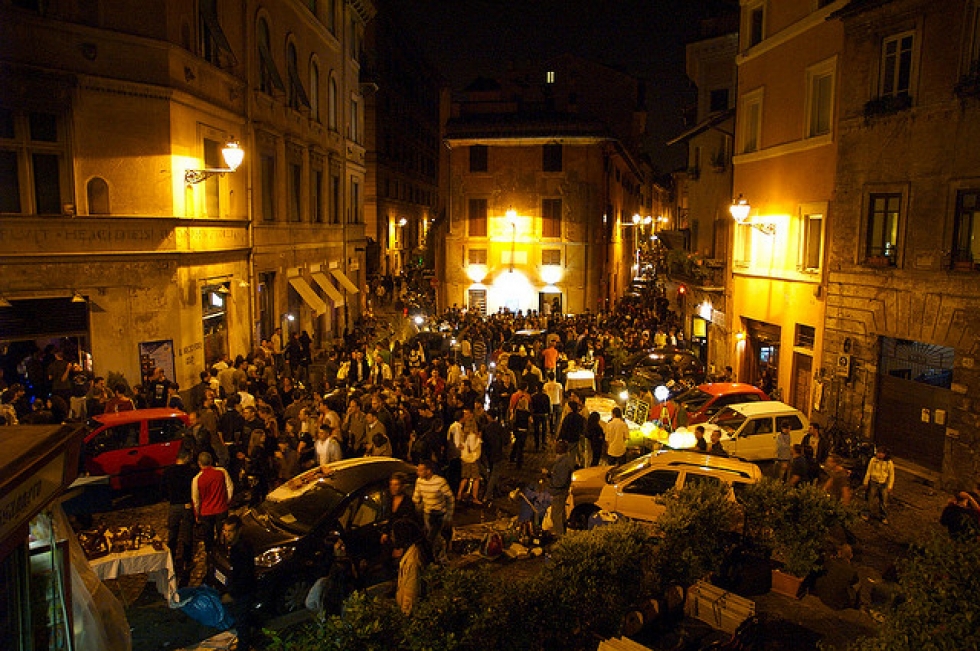With no doubt, one of the most known and important neighborhoods for the Roman night life and for the many trattorie offering local cuisine is Testaccio. This neighborhood, on the left bank of the Tiber river, south of the Aventine hill, presents the shape of an enormous square, mostly flat, with the exception of the artificial hill from which it takes its name: Mount Testaccio. This hill developed through the build-up of the shards of different anforae, (testae in Latin means shards, therefore the name Testaccio), containing food of any kind coming from the near fluvial harbor.
This harbor was called Emporium and it was, during the imperial era, the largest of the Eternal City. Here docked ships coming from all over the Roman Empire, and you could find the most diverse goods. A real portal to the ancient world. Mount Testaccio, also known as Monte dei Cocci (Mount of Shards) is a little less than 40 metres tall (though it seems that during antiquity it exceeded the height of 80 metres). It has a perimeter just shy of 1.500 metres and it has been established that it is made up of the shards of more than 53 millions of anforae. Once empty, the anforae could not be used again. Therefore, they were thrown away in this place: an actual dump of the ancient times. Of course, these remains were disposed in an orderly manner and then cover in lime. The lime had two effects: increasing the stability of the artificial hill, and eliminating bad smells that could come from decomposing food waste. It is not an impromptu dump. It even had a well-planned slope all around the hill for cars to arrive on top of it to drop the testae. There were public servants, called curatores, with the task of monitoring the unloading process. As you can see, they were extremely organized. The mount developed between the beginning of the imperial period (end of 1st century BC) and the second half of the 3rd century CE. During these 300 years the Emporium was particularly operative. Then its activity gradually decreased, until it stopped with the fall of the Roman Empire (end of 5th century CE). Thanks to the excavations held at the end of the 1800s, the history of this mount has been reconstructed, and we now have crucial information on Roman commercial habits. From the study of the testae, many questions could finally be answered, such as what products they traded, where they came from, how they preserved them and how they transported them. These very precious remains of clay are actual historical records of an extreme importance. Many remains of the anforae still present the tituli picti, a sort of brand revealing the name of the exporter, the content of the anfora, the shipping date and the origin of the product. During the Middle Ages, the hill had a great importance for it was the location where the carnival celebrations took place, with occasional displays of remarkable cruelty. For instance, from the top of the hill, they threw cars full of pigs, that were hunted by the people once they smashed into the ground. Later on, it was used as the final stop of the Stations of the Cross, after the carnival celebrations were moved in the 1400s to the via Lata, the one that today we call via del Corso. Back to the Middle Ages, especially from the 1100s on, the local residents dag the slopes of the hill, turning, the newly made rooms into stalls, cellars and taverns, without fearing any collapses. Nowadays, these spaces have the same purpose, indeed they were turned into clubs and restaurants. Why gouging rooms from this artificial hill, though? Easy! In this way they could take advantage of the insulating properties of the clay, out of which the anforae, constituting the hill, were made. The temperature of these locations is always constant, around 10° C. A sort of natural fridge, or better, “artificial”. What would have been better for a setting devoted to the preservation of foodstuffs?
Giuseppe Rosselli

